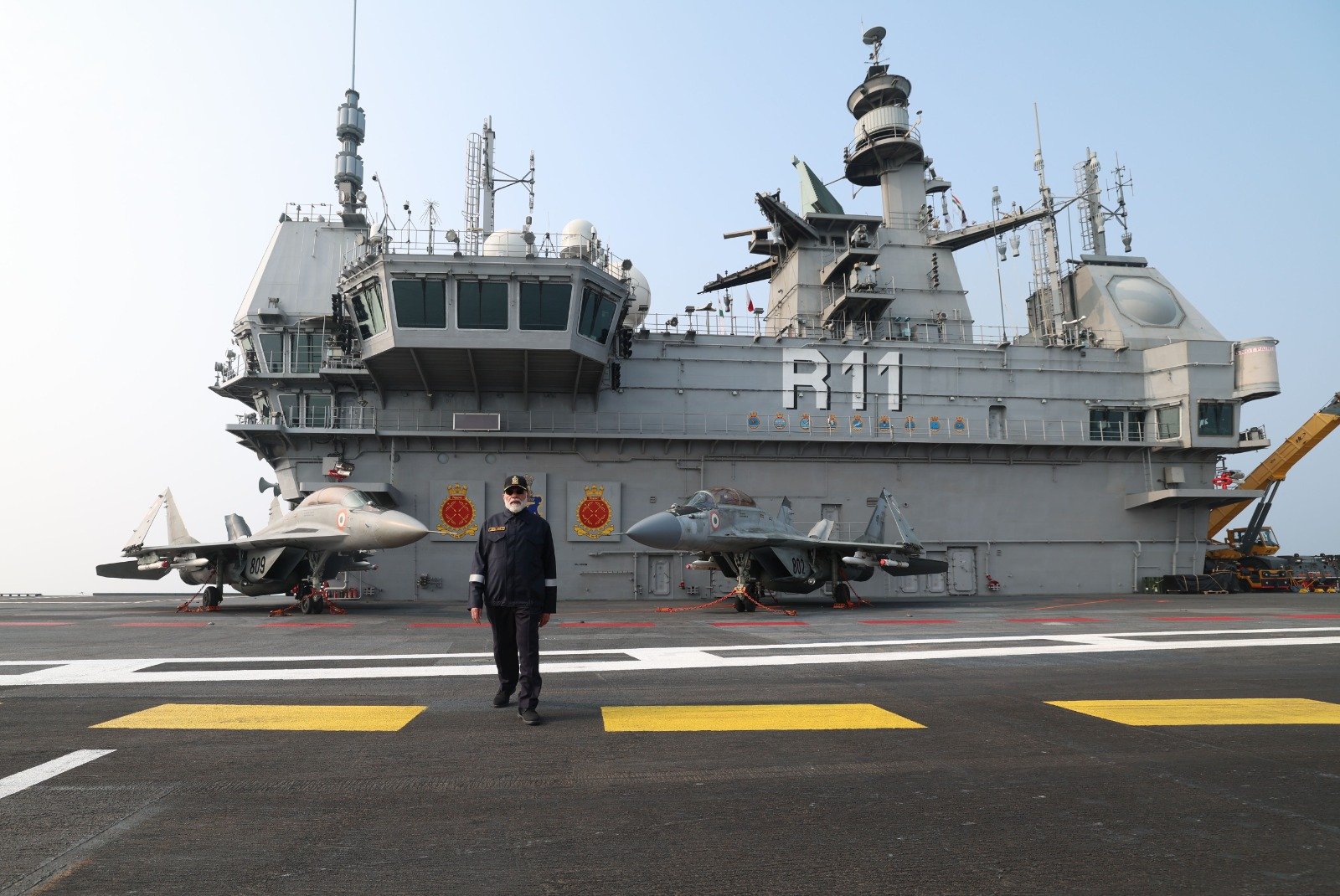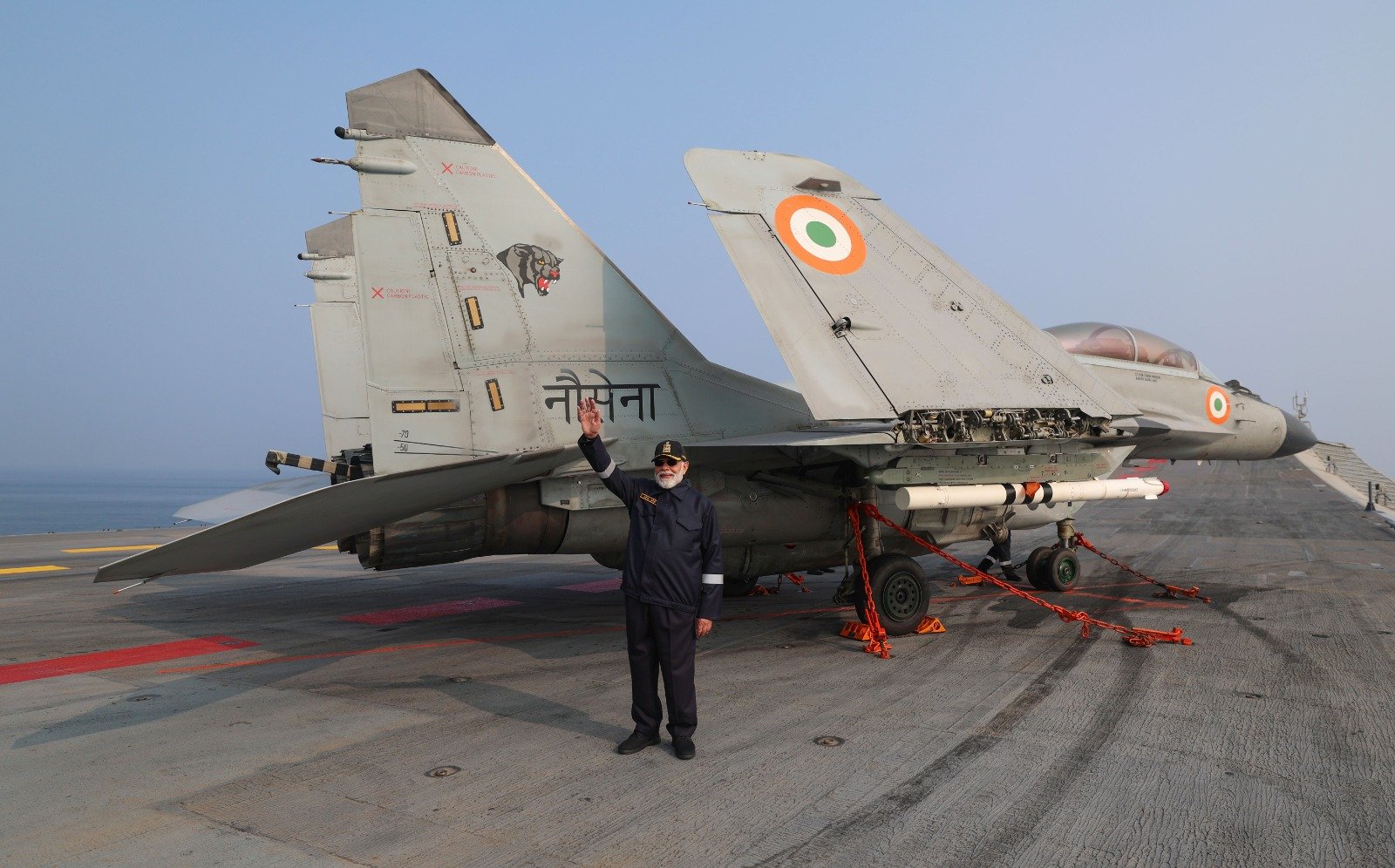During his visit to INS Vikrant on October 20, Indian Prime Minister Narendra Modi asserted that the aircraft carrier gave sleepless nights to Pakistan during the May 2025 border confrontation. The visit, marking the festival of lights, has once again drawn attention to the growing capability of the Indian Navy.
Narendra Modi celebrated Diwali with Navy personnel onboard INS Vikrant off the coast of Goa and Karwar (Karnataka) on October 20, as part of his annual tradition of celebrating the festival with the country’s armed forces.
Incidentally, the visit came about two years after INS Vikrant achieved “fully operational status,” on the day of Diwali in 2023, as reported by the EurAsian Times at the time.
“Today is an amazing day. This scene is memorable. Today, on one side, I have the ocean, and on the other, I have the strength of the brave soldiers of Mother India,” PM Modi told the personnel. “Today, on one side, I have infinite horizons and infinite sky, and on the other side, I have this giant, INS Vikrant, embodying infinite powers. The glow of the sun’s rays on the ocean’s waters is like the Diwali lamps lit by brave soldiers,” he added.
Notably, PM Modi spoke about the carrier’s role in the Indo-Pakistan conflict of May 2025, triggered by India’s precision strikes on the terrorist infrastructure inside Pakistan launched as part of Operation Sindoor.
“Just a few months ago, we saw that Vikrant made all of Pakistan sleepless,” the Prime Minister proudly declared in his address.
INS Vikrant is India’s pride!
This is the largest warship constructed indigenously. I recall the programme in Kochi when it was commissioned. And now, today, I had the opportunity to be here to mark Diwali. pic.twitter.com/FRCh3K7hJ9
— Narendra Modi (@narendramodi) October 20, 2025
The Indian Navy was mobilised during the brief border conflict with Pakistan, as recently acknowledged by Lt Gen Rajeev Ghai, Director General of Military Operations (DGMO).
“The Indian Navy was also in action… The Navy had sailed into the Arabian Sea, and when the DGMO spoke, they were very well poised. Had the enemy decided to take it any further, it could have been catastrophic for them and not only from the sea but from other dimensions,” he said emphatically.
Several reports since May have suggested that INS Vikrant was deployed near Pakistan, awaiting a green light to lead a maritime attack.
PM Modi said, INS Vikrant is not just a warship but is also a “testimony to 21st-century India’s hard work, talent, impact, and commitment.”
The 262 meters long and 62 meters wide Vikrant displaces approximately 43000 tons when fully loaded, with a maximum designed speed of 28 knots and an endurance of 7500 nautical miles.
The ship has around 2200 compartments designed for a crew of about 1600, including specialized cabins to accommodate women officers and sailors. The warship has been referred to as a “city on the move” due to its mammoth size.

Putting the size in perspective, the Indian Navy earlier explained that the aircraft carrier is the size of two football fields end to end. The hangar of the aircraft carrier is as big as two Olympic-size pools.
The aircraft carrier is equipped with a ski jump for launching aircraft and a set of three ‘arrester wires’ for their recovery onboard using the novel aircraft-operation mode known as Short Take-Off But Arrested Recovery (STOBAR).
It is built for Rs 20,000 crore by the Cochin Shipyard Limited (CSL), and has the capacity to accommodate nearly 30 combat aircraft and choppers.
Currently, India operates MiG-29s from INS Vikrant. It has an overall indigenous content of 76%. Notably, it is designed with a very high degree of automation for machinery operations, ship navigation, and survivability.
INS Vikrant is central to India’s strategic ambitions. It enhances India’s ability to project power far beyond its shores. But more importantly, it is like a floating airbase in the Indian Ocean Region (IOR) that can quickly be put to use in case of a contingency, such as the one during Operation Sindoor.
Positioned in the Arabian Sea or Bay of Bengal, Vikrant-led Carrier Battle Groups (CBGs) can deter adversaries, secure sea lines of communication (SLOCs) in the event of a contingency. Additionally, it could influence regional dynamics, particularly in countering China’s growing naval presence in the IOR and deterring Pakistan’s Navy.
Explaining the utility of aircraft carriers in modern combat in an exclusive interview with the EurAsian Times, India’s Chief of Naval Staff, Admiral Dinesh Kumar Tripathi, said, “Aircraft Carriers are central to the Indian Navy’s concept of operations. A Carrier Battle Group centered on an Aircraft Carrier is a means of projecting maritime power at sea. It is a self-contained and composite force capable of undertaking a wide range of operational tasks that no other platform can undertake. The ship and its airwing – fighters and helicopters – constitute a war-fighting system that has inherent flexibility as well as mobility and can be rapidly re-deployed based on emerging scenarios.”
In a nutshell, the INS Vikrant is indispensable for India’s maritime strategy, offering unmatched power projection, defense of economic interests, and deterrence. Additionally, its indigenous design strengthens self-reliance.
INS Vikrant will eventually be joined by a third aircraft carrier, which could even feature nuclear propulsion. As per the Indian Defense Ministry’s 15-year roadmap to modernise its military, termed ‘The Technology Vision and Capability Roadmap,’ India could build its third aircraft carrier, which could also feature India’s indigenous twin-engine deck-based fighter jet on its ramps.
However, given that an aircraft carrier takes 10 to 12 years to build, New Delhi would still rely on INS Vikrant and INS Vikramaditya until then.
MiG-29K Take Off For PM Modi
During his visit to INS Vikrant on October 20, PM Modi also witnessed the take off of the MiG-29K fighter jets—the only carrier-capable fighter jets available in the Indian inventory.
The Air Power Demo included the take-offs and landings of the fighter jets from the short runway, as seen in the video below. Notably, INS. Vikrant’s Short Take-Off But Arrested Recovery (STOBAR) system, with its ski-jump ramp and arresting gears, is optimized for MiG-29K operations. The aircraft’s thrust-vectoring engines and robust design allow it to take off and land on the carrier’s deck, enabling rapid deployment in combat scenarios.
Even though it is an aging aircraft, the deployment of MiG-29K fighters aboard INS Vikrant is a critical component of the carrier’s operational effectiveness and India’s overall naval strategy.
The aircraft entered service with the Indian Navy in 2010 and is expected to remain operational for many more years. The aircraft has operated out of the INS Vikramadity since then, and is now also stationed aboard INS Vikrant.
From the Air Power Demo at INS Vikrant! pic.twitter.com/XvrFL9peOK
— Narendra Modi (@narendramodi) October 20, 2025
The MiG-29K is designed for air superiority, precision strikes, and anti-ship/anti-submarine warfare. Equipped with advanced avionics, radar, and weapons like R-77 air-to-air missiles, Kh-35 anti-ship missiles, and guided bombs, it enables Vikrant to project power, defend the carrier battle group (CBG), and engage diverse threats.
The MiG-29K’s ability to carry up to 5,500 kilograms of ordnance and operate at a combat radius of 700-900 kilometers extends Vikrant’s strike range, allowing it to target threats far from the carrier group.
During the 2025 India-Pakistan standoff (Operation Sindoor), the MiG-29Ks on Vikrant were positioned to potentially strike targets like Karachi, showcasing their role in deterrence and power projection in the Arabian Sea.
By introducing the Rampage air-to-ground missile, which can reach targets up to 250 kilometers away, the Navy has further improved the attack capability of the aircraft.

The MiG-29K teamed up with the British F-35B for aerial exercises during the KONKAN 2025 combined carrier operations between INS Vikrant and HMS Prince of Wales, conducted earlier this month.
The two sides reportedly carried out a combined submarine hunt as an Indian Navy warship tried to evade detection by warships, helicopters such as the Merlin Mk2s embarked on HMS Prince of Wales, frigate HMS Richmond, and P8 Neptune Maritime Patrol Aircraft (MPA).
The MiG-29K has faced criticism for high maintenance costs and lower availability rates compared to its Western counterparts. However, India has sought to mitigate this through domestic maintenance facilities and upgrades, ensuring operational readiness on Vikrant.
The MiG-29K will eventually be replaced by the Rafale-Marines that are currently on order, but for now, it is pivotal to INS Vikrant’s role as India’s premier power projection platform. It provides versatile combat capabilities, supports regional deterrence, and strengthens India’s maritime security.
- Contact the author at sakshi.tiwari13 (at) outlook.com
- Follow EurAsian Times on Google News




